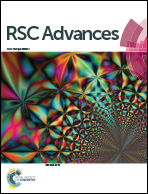Kinetics and gene diversity of denitrifying biocathode in biological electrochemical systems†
Abstract
Cathodic denitrification using a bioelectrochemical system removes nitrogen at a low C/N ratio, and also harvests energy as electricity. Denitrifying biocathodes were cultured using three electrode systems with nitrate (NO3−) and/or nitrite (NO2−) as electron acceptors. Results showed that denitrification of NOx− in biocathodes exhibit typical enzymatic reaction kinetics and denitrification rate follows the Monod equation, with rmax = 1.33 kg N m−3 d−1, Ks = 5.52 g L−1 for NO3− and rmax = 1.76 kg N m−3 d−1, Ks = 8.09 g L−1 for NO2−, respectively. Optimal cathodic efficiency was obtained at an initial substrate concentration of 0.5 g L−1. A high-throughput sequencing analysis of 16S rRNA gene showed high biodiversity in a denitrifying biocathode and nitrite contributed more to the formation of cathodic microbial community structure. Denitrification functional gene analysis revealed Pseudomonas are effective denitrifiers in a biocathode.



 Please wait while we load your content...
Please wait while we load your content...